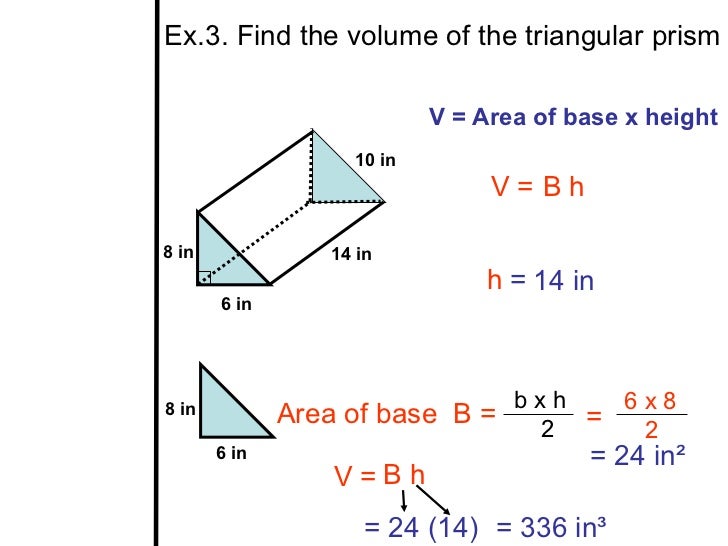

What terminology they may not understand in that definition and provide Identical ends, straight sides and the same cross-section. Introduce prisms to students as 3-dimensional shapes that have Them to identify and find the area of the cross section rather Depending on the rotation of the shape the front face The area of the ‘front face’ and multiply this by the length or Of cross-section first they will be able to calculate theĪ common misconception may arise if students are told to find Two hexagonal prisms are the same volume but are Whether the student ‘see’ the length or the height.Į.g. On the rotation of the shape will determine The cross section is, find the area of it and then Introduced as area of the cross section × length The cross section will be the same shape as the identical ends of the prism. Show how the cross section must be identical along the length (or height) of the shape.Īll these shapes are triangular prisms as they have identical triangular ends, straightĮdges and a uniform cross section. Rotations of the shape, so students become familiar with what is required to call a shape a When introducing new prisms such as a triangular prism show a variety of drawings and This formula only applies to rectangular prisms. Showing a justification for the formula will support student understanding that Rectangular prism made from 1 cm cubes or drawing one on a computer program such as

Clarify with students how this formula is established by showing a Students may be familiar with the formula length × width × height to find the volume ofĪ rectangular prism. Prisms are three-dimensional shapes with identical ends that can be cut into identicalĬross sections all along their length or height. To develop formulas to calculate the volume of other prisms such as triangular prisms. The volume of a rectangular prism from ( VCMMG259). At this level, students will continue to develop their understanding of volume and finding (base edge length and base triangle height length). Determine the angle between the body diagonal and the base plane (round to degrees).Ĭalculate the volume and surface area of a triangular prism if it is given: a = 6.8 dm.Va = 4 dm. Find its volume and surface area.Ĭalculate the volume and surface of a regular hexagonal prism with the edge of the base a = 6 cm with the corresponding height v1 = 5.2cm and the height of the prism h = 1 dm.Ĭalculate the volume and surface area of a regular quadrangular prism whose height is 28.6cm, and the diagonal body forms a 50-degree angle with the base plane.Ĭuboid ABCDEFGH with 10 cm height has a base edge length 6 cm and 8 cm. The regular triangular prism has a base edge of 8.6 dm and a height of 1.5 m. The angle from the plane of the sidewall and base plane is 60 degrees.Ĭalculate the volume of a regular triangular pyramid with edge length a = 12cm and pyramid height v = 20cm. Calculate the volume of the prism.Ĭalculate the volume and surface of the regular four-sided pyramid whose base edge is 4 cm long. It is given a regular perpendicular triangular prism with a height of 19.0 cm and a base edge of 7.1 cm. The axis of this opening passes through the center of the base of the cuboid. Calculate its volume.Ĭalculate the volume of a regular 5-side (pentaprism) pyramid ABCDEV if |AB| = 7.7 cm and a plane ABV, ABC has angle 37 degrees.Ĭalculate the regular quadrangular pyramid's surface whose base edge measured 6 cm, and the deviation from the plane of the base's sidewall plane is 50 degrees.Ī cylinder-shaped hole with a diameter of 12 cm is drilled into a block of height 50 cm with a square base with an edge length of 20 cm. The regular triangular prism has a base in the shape of an isosceles triangle with a base of 86 mm and 6.4 cm arms, the height of the prism is 24 cm. The body diagonal of a regular square prism has an angle of 60 degrees with the base, and the edge length is 10 cm. Determine the distance of point M from the BDH plane. Calculate the volume for the edge length a = 6 cm.Ī regular quadrilateral prism ABCDEFGH has a base edge A B 8 cm long and 6 cm high. Determine which ratio the edge AB divides by this plane.Ĭalculate the volume of a regular triangular prism whose height is equal to the length of the base edge. The edge of the CC' guides the ABCDA'B'C'D'cube, a plane that divides the cube into two perpendicular four-sided and triangular prisms, whose volumes are 3:2. We encourage you to watch this tutorial video on this math problem: video1 video2 video3 Related math problems and questions:Ī regular triangular prism with a base edge of 35 cm has a volume of 22.28 l.


 0 kommentar(er)
0 kommentar(er)
